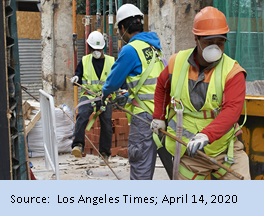Engineers known for unknowns: Role of an Engineer in epidemiological context for fizzling out COVID-19
By Eng. (Prof.) Mahesh Jayaweera & Eng. (Professor) Jagath Manatunge & Eng. (Dr.) Buddhika GunawardanaImminent impediments faced by engineers for engineering work in 2021
 With the advent of 2021, engineers, amidst COVID-19, will be faced with the dilemma of engaging in conventional engineering work. The government has been grappling with COVID-19 by the imposition of a multitude of non-pharmaceutical/clinical interventions from time to time to fizzle out the grim state of affairs prevailing in the country. Under such circumstances, we, engineers, may not come across an era conducive to continue practicing what we have been doing so far. One must not forget that the country expects the economy would recover to achieve a growth of 5.5% of GDP in 2021, in which engineers have a significant role to play, and they should be prepared to bear a greater responsibility. Therefore, a new paradigm shift would be imperative in contributing to the country’s expected economic growth. Fickle changes taking place in the country day by day because of the COVID-19 pandemic may not provide us a healthy environment to engage in usual engineering tasks; hence, a new school of thoughts in which harmonizing COVID-19-led settings with settings meant for proper delivery of outcomes expected of the engineering practice need to be explored.
With the advent of 2021, engineers, amidst COVID-19, will be faced with the dilemma of engaging in conventional engineering work. The government has been grappling with COVID-19 by the imposition of a multitude of non-pharmaceutical/clinical interventions from time to time to fizzle out the grim state of affairs prevailing in the country. Under such circumstances, we, engineers, may not come across an era conducive to continue practicing what we have been doing so far. One must not forget that the country expects the economy would recover to achieve a growth of 5.5% of GDP in 2021, in which engineers have a significant role to play, and they should be prepared to bear a greater responsibility. Therefore, a new paradigm shift would be imperative in contributing to the country’s expected economic growth. Fickle changes taking place in the country day by day because of the COVID-19 pandemic may not provide us a healthy environment to engage in usual engineering tasks; hence, a new school of thoughts in which harmonizing COVID-19-led settings with settings meant for proper delivery of outcomes expected of the engineering practice need to be explored.
Epidemiological context: an unavoidable circumstance for engineers
Epidemiology is a branch of medicine that deals with the incidence, distribution, transmission, and possible control of diseases and other factors relating to public health. The majority of engineers is not familiar with the intriguing principles of Epidemiology, mainly because of the known fact that we have not faced a pandemic like COVID-19 before. However, with the onset of COVID-19, engineers are forced to explore new avenues for combatting and curbing COVID-19 in order to contribute to a COVID-19-free era constructively. Engineers of some countries engage in predicting daily COVID-19 incidences and their fluctuations under the imposition of non-pharmaceutical interventions by the use of rigorous and time-tested engineering tools such as mathematical models, artificial intelligence, etc. A classic example is the research article titled, ‘The temporal association of introducing and lifting non-pharmaceutical interventions with the time-varying reproduction number (R) of SARS-CoV-2: a modelling study across 131 countries’ published in The Lancet Infectious Diseases – the most prestigious journal on infectious diseases in the world, a paper to which engineers have contributed immensely. This paper predicts the Sri Lankan situation with which one could get an insight into what awaits next for countries like Sri Lanka.
Moreover, engineers worldwide strive towards averting transmission of COVID-19 by networking with virologists, epidemiologists, medical practitioners, microbiologists, among others. We, the authors, contributed in this context by enlightening many by publishing a review paper in one of the prestigious journals of the world called ‘Environmental Research’ titled ‘Transmission of COVID-19 virus by droplets and aerosols: A critical review on the unresolved dichotomy’, which has been one of the best-downloaded articles for the last 90 days. This article articulates what an engineer can perform to fizzle out the transmission of COVID-19 and has become an eye-opener to many engineers.
Some of the engineers help governments decide on non-pharmaceutical intervention strategies to be imposed effectively and efficiently. For example, some have been involved in drafting ‘Guidelines for the implementation of non-pharmaceutical interventions against COVID-19’ by the European Centre for Diseases Prevention and Control in September 2020. This technical report unfolds the engineering perspectives with respect to plausible interventions. Nevertheless, in Sri Lanka, such best practices through networking with all professionals seem to be either not in existence or supposedly overlooked by the authorities. Sri Lanka is one of the countries whose reputation was on a high note until the Minuwangoda/Peliyagoda cluster emerged. Until early October, the Sri Lankan government was successful in controlling COVID-19 by the imposition and lifting (or relaxing) of a multitude of non-pharmaceutical interventions but seemed to be in a chaotic situation after the onset of the epicenters in Minuwangoda and Peliyagoda. The non-pharmaceutical interventions in Sri Lanka that have been in force include contact tracing, quarantine efforts, practicing social distancing and health screening, practicing hand hygiene, wearing masks, lockdown, and isolation episodes, deriving health-related benefits. To our understanding, the effectiveness of such interventions in today’s context is discernibly disputable. Unfortunately, the engineer’s role in this context has been undermined or overlooked by the government authorities.
Convincingly, engineers are also engaged in developing products that could destroy the COVID-19 virus once it spreads over indoor settings. www.eurekalert.org reports that Xin Ning, an engineer working in Aerospace Engineering, has been awarded a National Science Foundation grant to translate foldable space tools into medical equipment on earth in the USA. His invention is to develop a stretchable sensor that fits the patent’s chest and abdomen and a foldable field hospital that could aid in combatting the COVID-19 pandemic. Furthermore, many engineers are at the forefront of developing new devices for killing the COVID-19 virus in indoor settings, such as bipolar ionization units, ventilation enhancement with retrofitting HEPA filters, air purifiers embedded with ozonation or ultrafiltration technology, among many.
For all of these interventions, a prerequisite would be the principles of Epidemiology, a set of unknowns an engineer has to know, perhaps for the first time of his career. Even in applying the devices mentioned above, one has to have basic knowledge of Epidemiology as to how the destruction of viruses takes place with different technologies. In other words, unless we as a country combat the COVID-19 pandemic in the near future, engineers are invariably compelled to work in settings (known to be a new normal), which are exclusively novel physically, not fully amenable and comfortable psychologically, and out of the comfort zone we all used to work in. With time passing, we all have to embrace such a new normal, whether we like it or otherwise. We, the engineers known for resolving unknowns convincingly, would be no doubt confronted with the dilemma of making the new normal healthier and acceptable for the general public. The pressing question is, ‘are we ready to undertake such a daunting task’?
Another plausible viral attack known as Chapare hemorrhagic fever emerging loud
Even after successful control of COVID-19 and attaining the new normal, the engineers should be prepared to serve the society in the future to combat any other emerging pandemics. One such bleak possibility would be the Chapare hemorrhagic fever. By November 18, 2020, according to the Centers for Disease Control and Prevention (CDC) in the USA, the world will be forced to confront another imminent epidemic or maybe a pandemic to be caused by Chapare hemorrhagic fever (CHHF), which happened to have emerged for the first time in Bolivia. CHHF is a viral hemorrhagic fever caused by infection with the Chapare virus, which belongs to the arenavirus family. Arenaviruses usually spread to people through direct contact with infected rodents or indirectly through the urine or feces (droppings) of an infected rodent. There have been two documented outbreaks of CHHF to date. The first occurred in 2003 in Chapare Province, Bolivia, which resulted in one fatal case. The second outbreak occurred in November 2019 in Caranavi Province, Bolivia, and resulted in five confirmed cases, three of which were fatal. Though the rodent reservoir of the Chapare virus is unknown, similar arenaviruses are typically transmitted either through direct or indirect contact with the saliva, urine, and droppings of infected rodents. Examples of direct contact include bites and scratches by infected rodents. Examples of indirect contact include breathing in the virus when it is stirred into the air or ingestion of food contaminated with the urine, saliva, droppings of infected rodents.
An infected person can then spread the illness to other people through contact with the patient’s body fluids or during procedures in healthcare settings that can aerosolize (spray particles of) the infected person’s body fluids such as during chest compressions, CPR, and intubation, among others. Because there are a very few documented Chapare cases in humans, more research is needed to understand how the virus spreads and causes illness. Because CHHF is rare, and there have only been two confirmed outbreaks, the specific mortality and risk factors for mortality are unknown. In the first known outbreak, the only confirmed case was fatal. In the second outbreak in 2019, three out of five documented cases were fatal (case-fatality rate of 60%). There is currently no treatment for CHHF. Supportive therapy is important for recovery from and survival of CHHF. Such activities include hydration maintenance, management of shock (e.g., fluid resuscitation, administration of vasopressin stocks), sedation, pain relief, transfusions (when necessary).
A baffling task for a healthy new normal
With all alleged viral attacks on the cards, engineers need to help the Sri Lankan economy boom with the daunting task of achieving above-average and higher economic growth rates. Such tasks would only be possible by getting people acclimatized with the new normal that every one of us encounters the consequence of COVID-19. Maintenance of social distancing even higher distances than 2 m would be plausible. In such circumstances, engineers should invent new technologies or methods or popularize methods that would bring in people in contact not physically but remotely. Effective methods of contact tracing of susceptible persons/communities to the COVID-19 would be another area that urgently needs improvements. Inventions of efficient mobile apps seem to be inevitable in this regard. To this end, unmanned aerial vehicles have been popular in some countries, particularly in keeping vulnerable isolated or lock-down states appropriately monitored and served. Sri Lankan engineers should explore such possibilities in helping the government authorities restrict the people’s movements in COVID-19 affected areas; however, keeping them served and looked after as and when needed.
Wearing masks while engaged at work for extended hours could be a common sight in the future. However, wearing masks that effectively control the transmissibility of COVID-19 would undoubtedly be a hazel when it comes to comfortable breathing. Engineers need to invent masks with artificial intelligence-inbuilt so that, depending on the physical activity involved by the wearer, enhanced filtration could be expected. Such efforts need to be worked out at a reasonable cost so that many could afford such masks with improved performances. With the donning and doffing of personal protective equipment (PPEs) in the future, there will be loads of plastics, polymer materials, and other synthetics that are susceptible to transmitting the COVID-19 discarded with municipal solid waste into our open dump yards. Such acts could invariably accelerate the disease transmission, as new evidence infers that the COVID-19 virus lingers in surfaces for a longer time than expected and travels in water without loss of its viability. Engineers should understand the behavior of such viruses in different media based on the fundamentals of epidemiology and resort to effective methods of controlling such transfer episodes and pathways from one place to another. Besides, engineers must strive to develop devices for the safe disposal of infectious waste.
Building new makeshift hospitals, for infected persons, with materials reasonably cheap but reliable within a short period of time would be an important intervention in the future, particularly with more epicenters of COVID-19 emerging within the country. Our civil and material engineers may contribute toward this task enabling the government to fulfill this worthy effort with minimum lead and lag times. As of today, Sri Lanka faces a dearth of PCR machines that are essential for controlling the daily incidences. Mechatronic engineers should see to the possibilities of developing such devices locally for the benefit of Sri Lankans. In the future, mass gathering needs to be unprecedently restricted, but people may not compromise the clustering for purchasing essentials and non-essentials in supermarkets, popular shopping malls, among many others. Novel methods of reliable delivery of such commodities will be required in the future, and engineers need to shoulder major responsibilities of developing such modes.
In respect of making a healthy new normal for the general public, it is apparent that the engineer’s role in the future would be somewhat different, and new opportunities could even be unfolded in many areas of engineering. All in all, nothing is possible unless we, the engineers, go an extra mile contributing positively to resolve the enigma of how to live with COVID-19 safely and securely in a new normal. To this end, an engineer in the future may engage in many tasks previously unknown to them but pertinently important today with sound knowledge built on so-called Epidemiological principles.
 Eng. (Prof.) Mahesh Jayaweera
Eng. (Prof.) Mahesh Jayaweera
B.Sc. (Civil Eng), Ph.D. (Env Eng)
Professor, Department of Civil Engineering, University of Moratuwa
Chartered Engineer, Member of IESL, IWA, SLAAS-Section C
 Eng. (Prof.) Jagath Manatunge
Eng. (Prof.) Jagath Manatunge
B.Sc. (Civil Eng), M.Sc., DIC, Ph.D. (Env Eng)
Professor, Department of Civil Engineering, University of Moratuwa
Chartered Engineer, Member of IESL
 Eng. (Dr.) Buddhika Gunawardana
Eng. (Dr.) Buddhika Gunawardana
B.Sc. (Civil Eng), M.Eng. (st), M. Eng, Ph.D. (Env Eng)
Senior Lecturer, Department of Civil Engineering, University of Moratuwa
Associate Member of IESL, Member of IWA, SLAAS-Section C





